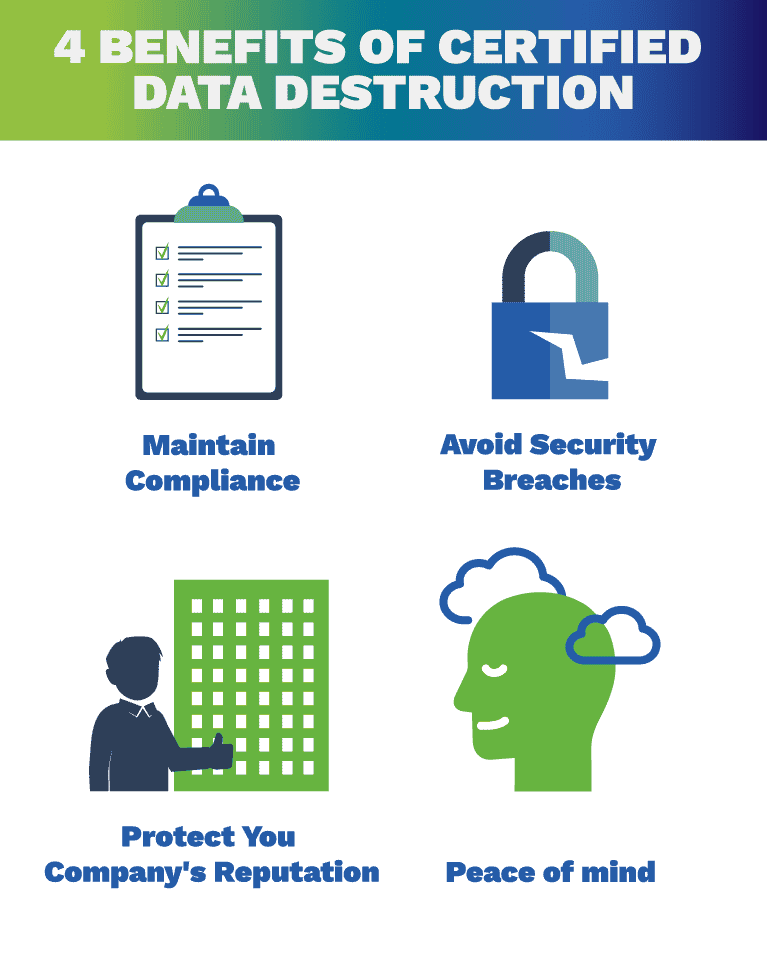Why Data Destruction is an Essential Part of Comprehensive Cyber Security
Why Data Destruction is an Essential Part of Comprehensive Cyber Security
Blog Article
Checking Out the Relevance of Information Destruction in the Context of Computer Protection Providers and Protecting Confidential Data
In an age where data breaches are significantly usual, the value of effective data damage can not be overemphasized. Organizations must embrace strict steps to make certain that delicate info is not just protected throughout its lifecycle but likewise emphatically gotten rid of when no much longer needed. The methods employed for data obliteration, paired with conformity to lawful criteria, play a critical role in maintaining confidentiality and trust. However, the implications of these practices extend beyond mere compliance, influencing a firm's online reputation and operational stability in the electronic market. What methods can companies carry out to enhance their information damage procedures?
Understanding Information Devastation
Data damage is an important part of computer safety and security that entails the irreversible removal of data from storage tools to avoid unauthorized access and potential information breaches. In an increasingly electronic landscape, organizations deal with increased threats associated with sensitive information being improperly accessed or exploited. Reliable information damage safeguards against these threats, guaranteeing that private dataâEUR" such as consumer information, intellectual home, and economic recordsâEUR" can not be recovered after disposal.
Understanding the significance of information destruction prolongs past plain compliance with legal and regulatory structures; it is necessary for maintaining organizational integrity and trust fund. When data is incorrectly managed or inadequately damaged, the effects can be serious, consisting of economic loss, reputational damage, and lawful obligations.

Approaches of Information Eradication

One prevalent approach is data wiping, which includes overwriting existing data with random patterns several times. This strategy renders the original data irretrievable, making it a popular option for companies looking for to shield personal details.
One more approach is degaussing, which makes use of an effective electromagnetic field to interrupt the magnetic domains on storage space tools, properly getting rid of the data. This approach is especially efficient for magnetic media however is not relevant to solid-state drives.
Physical devastation is one more durable technique, including the shredding or squashing of storage space devices. This approach guarantees that data recovery is essentially impossible, making it excellent for highly delicate information.
Last but not least, security can act as a complementary method to data obliteration. By encrypting data before removal, companies can add an extra layer of protection, making sure that even if residues are recovered, they continue to be hard to reach without the decryption trick. Each approach should be chosen based on the level of data level of sensitivity and the certain safety and security requirements of the company.
Legal Conformity and Information Safety
Organizations must browse a complicated landscape of legal demands associated with information safety and security, particularly after executing techniques of information elimination. Numerous guidelines, such as the General Data Security Law (GDPR) and the Health And Wellness Insurance Portability and Accountability Act (HIPAA), enforce stringent standards on just how organizations must deal with and dispose of sensitive data. Failing to follow these policies can result in significant legal effects, consisting of considerable fines and reputational damages.
Data devastation processes need to be meticulously documented to show conformity with relevant regulations and standards. This documentation not just functions as proof published here of adherence to legal commitments but also highlights a commitment to guarding sensitive info. Organizations should additionally establish clear plans concerning data retention and devastation timelines, making certain that information is not held longer than necessary.

Furthermore, routine audits and evaluations of data destruction practices are important to preserve compliance and adapt to developing lawful frameworks (data destruction). By proactively attending to legal demands, companies can alleviate dangers related to information violations and show their commitment to information safety. Eventually, focusing on lawful compliance in data devastation procedures is not just my review here a regulative obligation, however a fundamental facet of a robust information safety and security technique
Effect On Business Track Record
The track record of a business can be considerably influenced by its approach to information devastation and administration. In today's digital landscape, where data breaches can take place at any minute, the failing to effectively take care of delicate info can bring about serious effects. Organizations that inadequately manage information damage risk subjecting private customer details, which not only breaks privacy legislations however likewise erodes trust fund among customers and stakeholders.
A damaged track record can cause lowered customer commitment, as customers end up being reluctant to engage with a company that has actually shown negligence in safeguarding their information. Additionally, unfavorable publicity surrounding an information breach can have an enduring effect, as potential clients might be prevented by the regarded absence of protection. This can bring about a straight decrease in profits and market share.
Furthermore, services that focus on information destruction as component of their safety and security strategy can boost their credibility by showcasing their dedication to securing delicate details. By taking on rigid information administration techniques, companies can not just alleviate risks but also position themselves as reliable entities in their particular markets, therefore enhancing their general brand name picture.

Finest Practices for Secure Disposal
Implementing ideal practices for secure disposal of data is crucial for mitigating dangers connected with information violations and making sure conformity with personal privacy laws. Organizations should take on a thorough information disposal policy that details treatments for both digital and physical information devastation.
For physical data storage space devices, such as hard disk drives, shredding or degaussing is recommended to stop data healing. In addition, organizations should keep a chain of guardianship paperwork throughout the disposal process, making sure accountability and traceability of disposed products.
For electronic data, using software that read this article abides by industry requirements for data cleaning is critical. This software application needs to overwrite existing data numerous times, making recuperation virtually difficult. It is additionally crucial to validate the efficiency of the data destruction procedure via audits or third-party evaluations.
Educating employees on safe disposal practices adds one more layer of safety and security, as human mistake can usually cause data exposure. Frequently upgrading and reviewing disposal plans makes certain positioning with evolving guidelines and technological innovations. By implementing these finest practices, organizations can substantially lower the risk of unapproved information access and boost their overall data protection technique.
Conclusion
Finally, information damage is a basic aspect of computer protection services that makes sure the defense of secret information from unapproved gain access to. Executing reliable methods of data elimination, adhering to lawful conformity, and recognizing the effect on company online reputation are essential elements of a thorough data safety strategy. By adopting finest techniques for safe disposal, organizations can promote count on with clients and protect sensitive information, inevitably adding to a more secure digital landscape.
In an age where information breaches are increasingly usual, the importance of efficient data devastation can not be overstated.Information destruction is an essential component of computer safety that involves the long-term elimination of data from storage space gadgets to stop unapproved gain access to and possible information breaches. Organizations ought to additionally develop clear plans pertaining to information retention and damage timelines, ensuring that data is not held longer than needed.
By proactively resolving legal demands, organizations can mitigate threats associated with data breaches and show their commitment to information protection (data destruction). Ultimately, focusing on lawful conformity in information devastation procedures is not just a regulative responsibility, however a basic facet of a durable data safety approach
Report this page